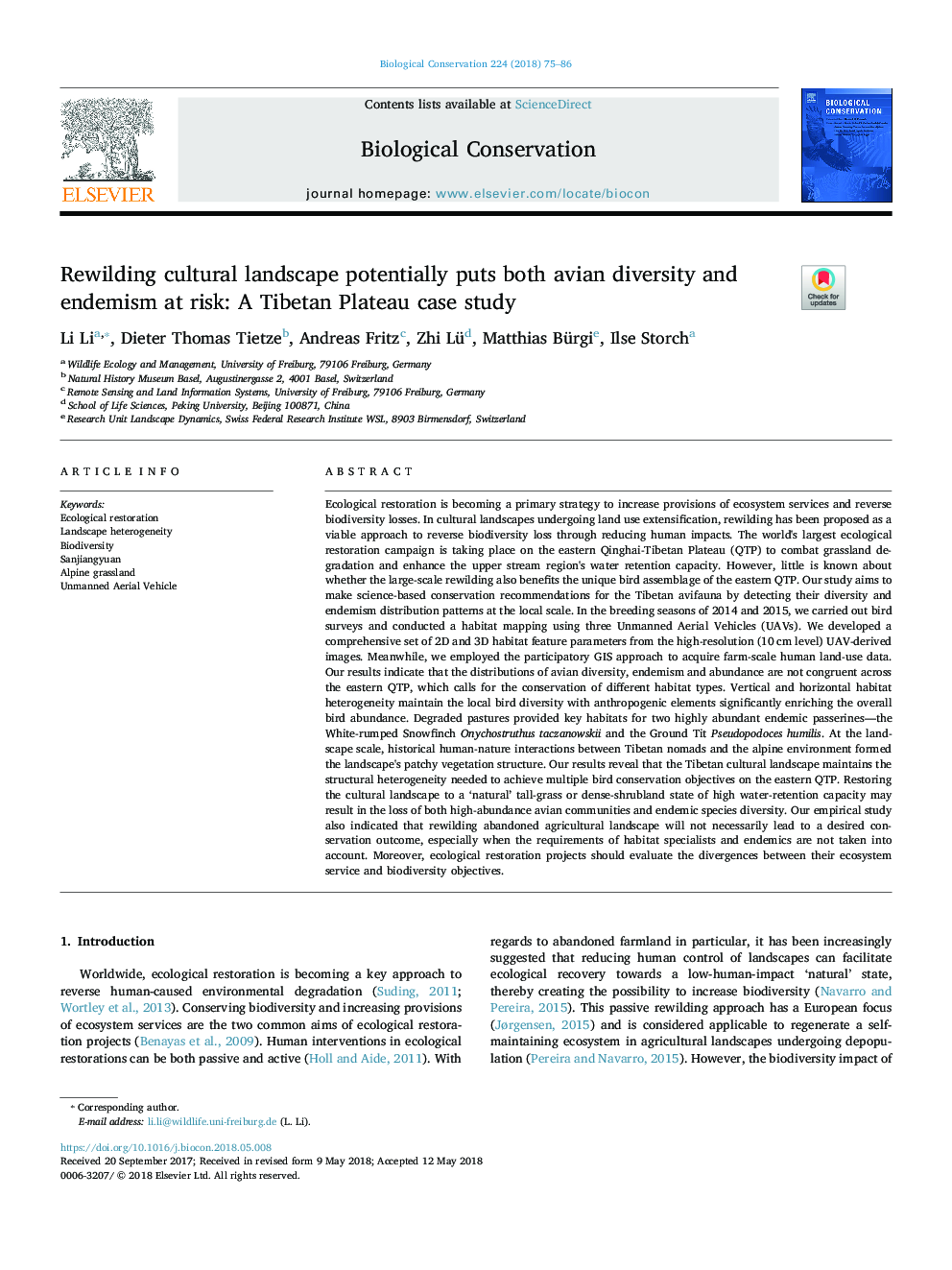| کد مقاله | کد نشریه | سال انتشار | مقاله انگلیسی | نسخه تمام متن |
|---|---|---|---|---|
| 8847181 | 1617881 | 2018 | 12 صفحه PDF | دانلود رایگان |
عنوان انگلیسی مقاله ISI
Rewilding cultural landscape potentially puts both avian diversity and endemism at risk: A Tibetan Plateau case study
ترجمه فارسی عنوان
چشم انداز فرهنگی چشم انداز به طور بالقوه هر دو تنوع و انزجار پرندگان را در معرض خطر قرار می دهد: یک مطالعه موردی فلات تبت
دانلود مقاله + سفارش ترجمه
دانلود مقاله ISI انگلیسی
رایگان برای ایرانیان
کلمات کلیدی
موضوعات مرتبط
علوم زیستی و بیوفناوری
علوم کشاورزی و بیولوژیک
بوم شناسی، تکامل، رفتار و سامانه شناسی
چکیده انگلیسی
Ecological restoration is becoming a primary strategy to increase provisions of ecosystem services and reverse biodiversity losses. In cultural landscapes undergoing land use extensification, rewilding has been proposed as a viable approach to reverse biodiversity loss through reducing human impacts. The world's largest ecological restoration campaign is taking place on the eastern Qinghai-Tibetan Plateau (QTP) to combat grassland degradation and enhance the upper stream region's water retention capacity. However, little is known about whether the large-scale rewilding also benefits the unique bird assemblage of the eastern QTP. Our study aims to make science-based conservation recommendations for the Tibetan avifauna by detecting their diversity and endemism distribution patterns at the local scale. In the breeding seasons of 2014 and 2015, we carried out bird surveys and conducted a habitat mapping using three Unmanned Aerial Vehicles (UAVs). We developed a comprehensive set of 2D and 3D habitat feature parameters from the high-resolution (10â¯cm level) UAV-derived images. Meanwhile, we employed the participatory GIS approach to acquire farm-scale human land-use data. Our results indicate that the distributions of avian diversity, endemism and abundance are not congruent across the eastern QTP, which calls for the conservation of different habitat types. Vertical and horizontal habitat heterogeneity maintain the local bird diversity with anthropogenic elements significantly enriching the overall bird abundance. Degraded pastures provided key habitats for two highly abundant endemic passerines-the White-rumped Snowfinch Onychostruthus taczanowskii and the Ground Tit Pseudopodoces humilis. At the landscape scale, historical human-nature interactions between Tibetan nomads and the alpine environment formed the landscape's patchy vegetation structure. Our results reveal that the Tibetan cultural landscape maintains the structural heterogeneity needed to achieve multiple bird conservation objectives on the eastern QTP. Restoring the cultural landscape to a 'natural' tall-grass or dense-shrubland state of high water-retention capacity may result in the loss of both high-abundance avian communities and endemic species diversity. Our empirical study also indicated that rewilding abandoned agricultural landscape will not necessarily lead to a desired conservation outcome, especially when the requirements of habitat specialists and endemics are not taken into account. Moreover, ecological restoration projects should evaluate the divergences between their ecosystem service and biodiversity objectives.
ناشر
Database: Elsevier - ScienceDirect (ساینس دایرکت)
Journal: Biological Conservation - Volume 224, August 2018, Pages 75-86
Journal: Biological Conservation - Volume 224, August 2018, Pages 75-86
نویسندگان
Li Li, Dieter Thomas Tietze, Andreas Fritz, Zhi Lü, Matthias Bürgi, Ilse Storch,
